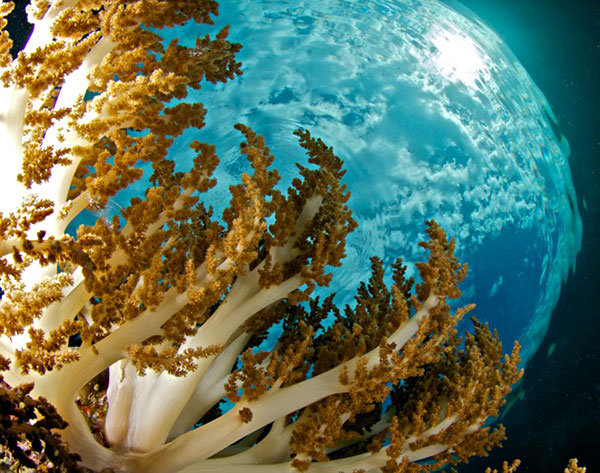Willibrord Snellius (b. 1580 Willebrord Snel van Royen) was a Dutch astronomer and mathematician, remembered particularly for his derivations of the radius of the earth and the law of refraction. It's hard to say whether he understood the implications his work would have on our underwater photography! When we take our cameras underwater, the water itself becomes a lens of sorts. Light refracts, or bends, as it travels through water—sometimes creating interesting effects.
How to get the effect
We start with a lens around 15mm or wider (it does not need to be a fisheye lens). Try holding the housing exactly level with the surface—that is, with the lens opening pointing straight up—to produce the rounded image we now call Snell’s Window. The resulting underwater image can be a full circle with a fish-eye view, or a partial curve across the corner of your frame, all depending on the angle of the lens in relation to the surface. Looks can be deceiving... Snell's Window often appears to be a level view, but if you see the curved effect and textured surface of the water, you know the lens is pointing straight at the surface!
Composing with Snell
Viewing and composing these images can be difficult. Looking up will send any water in your mask straight into your nose. Looking straight up can also be disorienting, making it hard to tell if you are descending, ascending, or about to run into something. To experiment with Snell’s Window, try taking your wide lens and "shoot from the hip." Hold the housing out in front of you, lens pointing up, and sight over it instead of through the eyepiece. This will allow you to get in close to a subject without touching the reef. As you get used to the angle of your wide lens you will get better at judging the composition of your frame before seeing the post-shot preview. It may help to imagine the angle of coverage that your lens sees as a 90° angle. It is probably wider than this, but a right angle is easy to visualize coming out of your dome port.
There are helpful aspects to working with Snell's Window. For instance, by pointing the lens up and into the light, you will be able to use a very small aperture (i.e. large f-number, like f/22). This yields a very wide depth of field. At these smaller apertures, an object right next to your dome port can be in sharp focus... and so can the clouds in the sky, if your water is flat enough!

Lighting Snell's Window
To compete with the onslaught of available light, your strobes will be going off at a very high power. Make sure they're pointed at the subject in the foreground so you're not wasting their output on the open water.
If you turn the strobes off and shoot with only natural light, it will produce sharp silhouettes. A popular subject for this is the dive boat with the sun behind it, and it is always worth taking a look upwards as you begin your decent. Either technique can produce stunning effects depending on the subject, so it's worth practicing both!
Bonus Tip
If you want to freeze light rays, try to use a fast shutter speed (1/250th second or faster).














